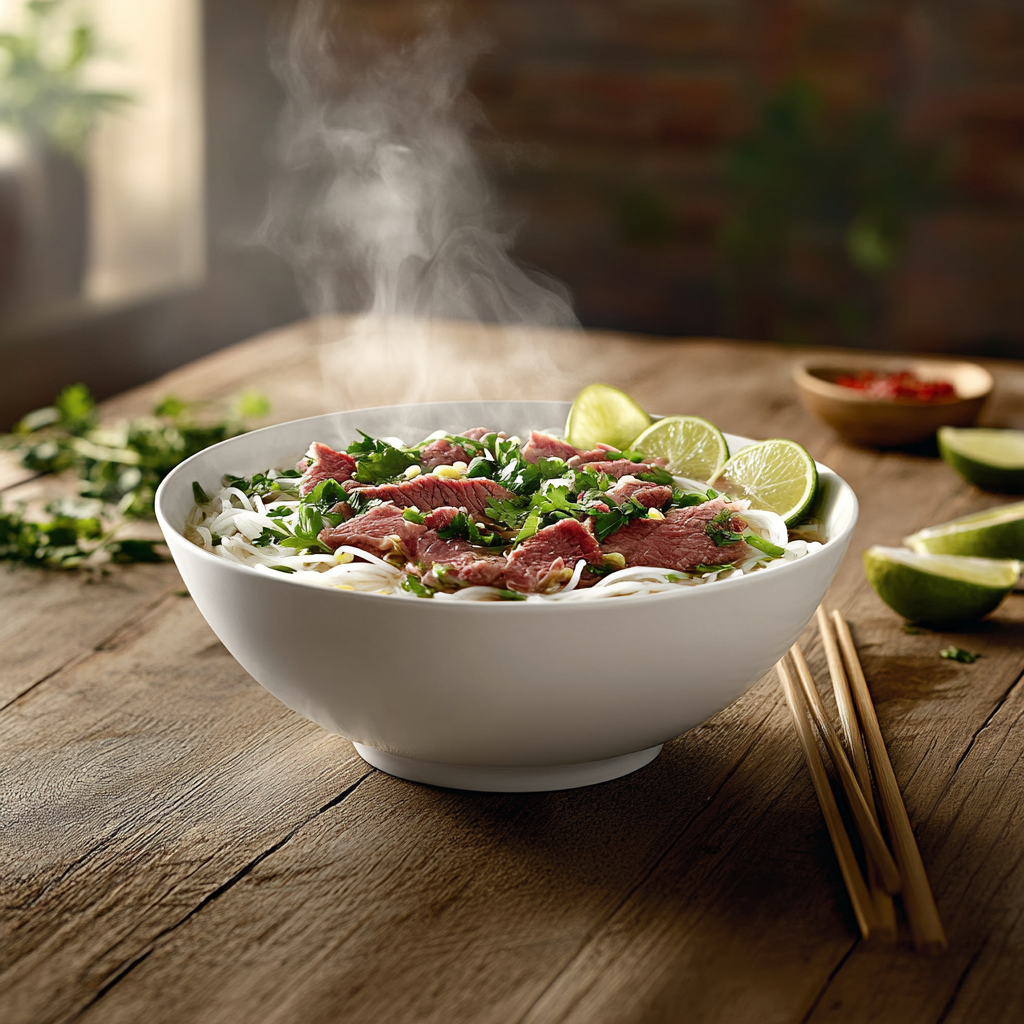Table of Contents
Vietnamese pho (pronounced “fuh”) is more than just a noodle soup—it’s a culinary masterpiece and a cultural symbol. With its aromatic broth, tender beef, and fresh herbs, pho captures the heart and soul of Vietnamese cuisine. A dish that’s as nourishing as it is flavorful, pho has become a global sensation, loved for its unique balance of spices and textures.
This recipe will guide you step-by-step through making authentic Vietnamese pho from scratch. While it requires patience and care, the end result is a bowl of soup so rich in flavor that it will transport you straight to the streets of Hanoi or Ho Chi Minh City.
The History of Vietnamese Pho
Pho originated in Northern Vietnam in the early 20th century, influenced by French and Chinese culinary traditions. The French introduced the use of beef in soups, while Chinese spices like star anise and cinnamon became essential components of the broth. Over time, pho spread to the southern regions, where it evolved into a sweeter, more herbaceous version.
Today, pho is a cornerstone of Vietnamese cuisine, enjoyed as a hearty breakfast, a comforting lunch, or even a late-night meal. Its cultural significance and global popularity make it a dish that’s as iconic as it is delicious.
Nutritional Benefits of Vietnamese Pho
Pho isn’t just flavorful—it’s also packed with nutrients that make it a wholesome meal:
- Protein-Rich Beef: Provides essential amino acids for muscle growth and repair.
- Collagen-Rich Broth: Bone-based broths are a source of collagen, which supports joint and skin health.
- Herbs and Spices: Fresh herbs like basil and cilantro are rich in antioxidants, while spices like star anise and ginger have anti-inflammatory properties.
- Low in Fat: Traditional pho broth is light and low in fat, making it a healthy choice.
Ingredients for Authentic Vietnamese Pho
Making pho from scratch requires a combination of fresh ingredients, aromatic spices, and time to develop the broth’s rich flavor.
For the Broth
- 2 lbs beef bones (marrow and knuckle bones)
- 1 lb beef brisket or flank steak
- 1 medium onion, halved
- 1 piece (3 inches) fresh ginger, halved lengthwise
- 3 whole star anise
- 4 cloves
- 1 cinnamon stick
- 1 tbsp coriander seeds
- 10 cups water
- 2 tbsp fish sauce
- 1 tbsp sugar
For the Soup
- 12 oz rice noodles (medium-width)
- 1/2 lb beef sirloin, thinly sliced
- 1/2 cup bean sprouts
- 1/4 cup fresh cilantro, chopped
- 1/4 cup Thai basil leaves
- 1 lime, cut into wedges
- 1-2 fresh chilies, thinly sliced
- Hoisin sauce and sriracha (for serving)
How to Make Authentic Vietnamese Pho
Step 1: Prepare the Bones
- Rinse the beef bones thoroughly under cold water.
- In a large pot, cover the bones with water and bring to a boil. Let it boil for 5 minutes to release impurities, then discard the water and rinse the bones again.
Step 2: Char the Onion and Ginger
- Heat a dry skillet over medium-high heat.
- Place the onion halves and ginger on the skillet and char until blackened, about 3-5 minutes. This step adds depth to the broth.
Step 3: Toast the Spices
- In a small pan, toast the star anise, cloves, cinnamon stick, and coriander seeds over medium heat for 2 minutes, until fragrant.
- Add the toasted spices to a spice bag or cheesecloth to keep them contained in the broth.
Step 4: Simmer the Broth
- In a large pot, combine the bones, charred onion and ginger, toasted spices, and water.
- Bring to a boil, then reduce the heat to low and let it simmer gently for 6-8 hours, skimming any impurities from the surface.
- After simmering, strain the broth through a fine-mesh sieve into another pot, discarding the solids.
Step 5: Cook the Noodles
- Soak the rice noodles in warm water for 30 minutes, then drain.
- Cook the noodles in boiling water for 1-2 minutes, until tender, then drain and rinse with cold water.
Step 6: Assemble the Pho
- Divide the cooked noodles among bowls.
- Top each bowl with thinly sliced beef sirloin and ladle the hot broth over it to cook the beef.
- Add bean sprouts, cilantro, and Thai basil to each bowl.
Step 7: Serve with Garnishes
- Serve the pho with lime wedges, sliced chilies, hoisin sauce, and sriracha on the side.
- Let guests customize their bowls to their taste.
Tips for Perfect Pho
- Choose Quality Bones: Marrow and knuckle bones are ideal for creating a rich, flavorful broth.
- Don’t Rush the Broth: The longer you simmer, the more flavorful the broth becomes. 6-8 hours is ideal.
- Slice Beef Thinly: Freeze the beef for 15-20 minutes before slicing to make thin, even slices.
- Skim the Broth Regularly: Removing impurities ensures a clear and clean-tasting broth.
Variations of Pho
- Pho Ga (Chicken Pho): Substitute chicken bones and chicken breast for the beef to make a lighter version.
- Vegan Pho: Use vegetable broth, mushrooms, and tofu instead of meat.
- Spicy Pho: Add chili oil or extra sliced chilies for a fiery kick.
- Seafood Pho: Include shrimp, scallops, or fish balls for a coastal twist.
Best Side Dishes for Pho
Pair your bowl of pho with these popular Vietnamese side dishes:
- Spring Rolls (Gỏi Cuốn): Light and refreshing, filled with shrimp, vermicelli, and fresh herbs.
- Vietnamese Iced Coffee (Cà Phê Sữa Đá): A strong, sweet coffee to complement the savory flavors of pho.
- Pickled Vegetables: Crunchy and tangy, perfect for balancing the rich broth.
FAQs About Vietnamese Pho
1. Can I make pho ahead of time?
Yes! The broth can be made ahead and stored in the refrigerator for up to 3 days or frozen for up to 3 months.
2. What’s the best cut of beef for pho?
Brisket, flank steak, and sirloin are ideal for pho due to their tenderness and flavor.
3. How do I store leftover pho?
Store the broth, noodles, and toppings separately to prevent the noodles from absorbing too much liquid.
4. Can I use store-bought broth?
While homemade broth is best, you can use high-quality store-bought broth for a quicker version.
Conclusion
Pho is much more than a soup—it’s a celebration of Vietnamese culture, tradition, and flavors. From the aromatic spices to the fresh herbs and tender beef, every element of pho contributes to its irresistible appeal.
Making pho from scratch may take time, but the result is a bowl of soup that’s as rewarding to prepare as it is to eat. Whether you’re savoring it as a hearty breakfast or serving it as a centerpiece for a dinner gathering, pho is a dish that brings people together.
So grab your pot, gather your ingredients, and embark on a culinary journey to Vietnam. Once you’ve tasted the authentic flavors of homemade pho, there’s no going back.

